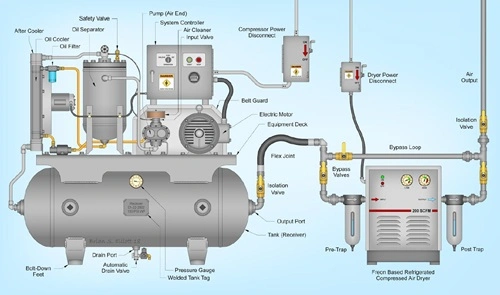A screw air compressor is a fundamental piece of machinery used across various industries to provide compressed air. Understanding its components is crucial for optimal performance and longevity. In this article, we’ll discuss the major parts of a screw air compressor, their functions, and their importance in operation.
Compressor Element: The Heart of the Screw Air Compressor

The compressor element, also known as the air end, is where the actual compression occurs. It is designed with high-quality components to ensure efficient and reliable operation. This element is the core of the screw air compressor, responsible for creating the high-pressure airflow needed for many industrial applications.
Screws/Rotors: The Driving Force Behind Compression
The screws or rotors are critical components of a screw air compressor. They consist of paired male and female rotors that rotate at high speeds within cylinders, creating compression chambers through which ambient air is drawn, compressed, and discharged. The precise interaction of these screws is essential for achieving optimal compression ratios and performance.
Compression Cylinders: The Pathway for Air Compression
Compression cylinders serve as the framework through which air passes during the compression process. Typically made from cast iron or steel, these cylinders ensure durability and operational capacity. They guide the air from the intake to the compression stage, achieving pressurization in the system.
Air Filters: Protecting Internal Components
Inlet air filters are positioned at the entrance of a screw air compressor to protect internal mechanisms from dust, moisture, and particulate matter. Effective filtration extends the life of critical compressor elements, minimizes damage, and improves air quality for downstream uses.
Oil Filters: Maintaining Air Purity and Lubrication
Oil filters perform a dual role by cleaning the compressed air of contaminants and maintaining the oil lubricants in the system. They screen oil from the compressed air flow, preventing oil contamination in downstream processes. Proper maintenance of oil filters is essential for extending compressor life.
Oil Cooler: Regulating Operational Temperatures
The oil cooler is responsible for controlling the heat generated in a screw air compressor. It cools compressor oil before recirculation, maintaining operational temperatures within acceptable ranges and reducing thermal stress on critical components.
Bearings: Enabling Smooth Rotation
Bearings are strategically positioned to support and stabilize the rotation of screws and other moving parts. Radial load bearings and axial bearings are crucial for distributing loads, ensuring the compressor operates efficiently and prolonging its lifespan.
Hoses: Facilitating Fluid Transfer
Hoses are used to transfer oil and air between components at different positions in the compressor system. Proper selection and placement of hoses are vital for maintaining operational integrity and protecting sensitive components.
Suction Valve: Controlling Airflow
The suction valve controls air entering the compression chamber. Types of suction valves include poppet, plate, and ring valves, which regulate airflow and compress efficiency as required by operation.
Motor: Powering the Compressor
The motor is the primary power source that drives the screws and operates the compressor. Typically powered by electrical energy, it offers consistent performance in most industrial applications. Advanced motor systems may include intelligent controls for monitoring and operation.
Control System: Monitoring and Regulation
A control system is necessary for supervising the operation of a screw air compressor. It allows operators to monitor performance metrics, set settings, and maintain proper system behavior. The control system regulates components and operational parameters to ensure the compressor is safe, efficient, and reliable.
Tanks: Storing Pressurized Air
Many screw air compressors include storage tanks for pressurized air. These tanks are sized according to application needs and act as reservoirs to maintain air pressure consistency during intermittent usage.
Oil Separators: Maintaining Air Purity
Oil separator tanks filter and separate excess oil from compressed air streams in oil-lubricated screw air compressors. They prevent oil contamination in downstream processes and keep compressed air clean of oil residue, enhancing system reliability and prolonging compressor lifespan.
Preserving Your Screw Compressor Components
Regular maintenance is crucial for extending the operational life of screw air compressor components and reducing downtime. Following a proactive maintenance schedule and using quality products and services can help operators achieve high system efficiency, minimize the risk of malfunction, and ensure consistent performance in compressed air applications. Partnering with reliable service providers and adhering to quality maintenance practices are key to ensuring the longevity of your screw air compressor.

